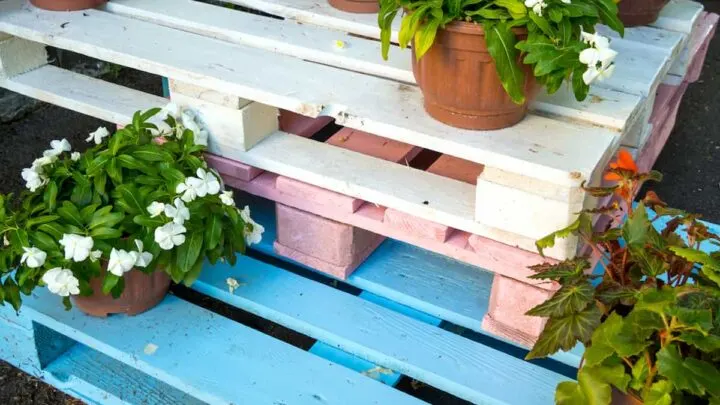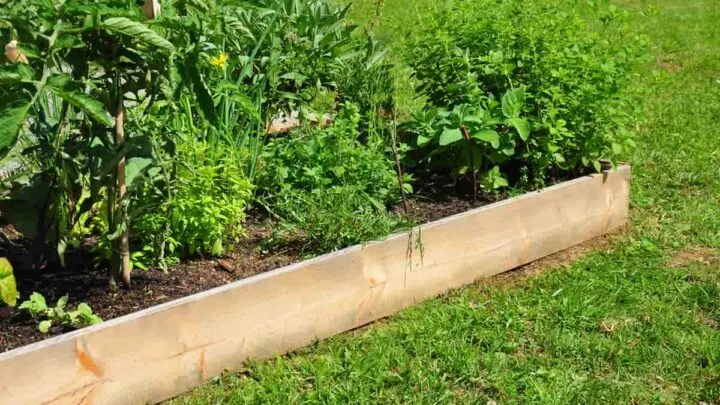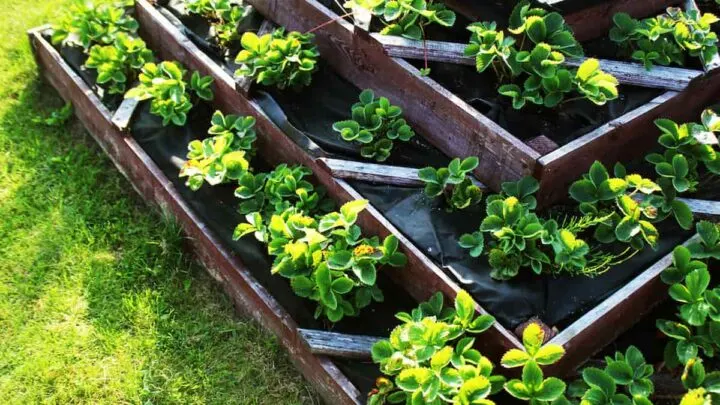Raised garden beds add significant convenience to your backyard gardens. If you grow flowers, the abundance of beautiful colorful petals and foliage spilling from the sides can add the pop of brilliance you were hoping for without having to dig into the ground. However, if you are growing crops like vegetables or herbs, they can be a bit drab when compared to their flowering counterparts.
Naturally, you would think of the next best way to add color to your outdoor raised garden space: painting or staining the wood. But can you paint garden beds? Would it be bad for the plants? What about upcycling wood that is already painted?
Yes, you can paint garden beds. Choosing nontoxic paints and stains is a great way to add color to your garden beds without risking the soil quality or exposure to toxic chemicals.
Read on to learn more about painting raised garden beds, when you should say no to color, and other alternatives to painting or staining.

Can I Use an Old Fence for my Raised Garden Bed?
When you live in farm country, it is easy to find an abundance of old wood. Whether the wood is from an old red barn, a faded blue or white from an old picket fence, or a fun color from an old chicken coop, it is best not to use these materials to make a raised garden bed.
While the allure may be hard to resist, it is best to opt for new materials when constructing your garden, especially if you will be growing food crops.
Weathering and fading may make these pieces of wood romantic, but they are most likely painted with paint that contains lead or other toxic chemicals. Since there is no easy way to test the paint samples, it is impossible to know what type of paint was used.
Unfortunately, as much as you would like to upcycle and reuse the wood, it is best to forget it. Many people will consider lining the bed with a plastic sheet to help the soil avoid contact with the wood, but plastic is not an excellent option for plants either.
If you are dead set on reusing your antique wood, experienced gardeners recommend investing in metal to line your raised garden bed, creating a barrier between the shell of the wood. This arrangement will give your planters a wood look while still providing a safe environment for your plants.
Can I Paint my Raised Garden Bed?
Since we have already discussed why you should source new wood for your raised garden bed, how can you add color? Choosing a nontoxic paint or stain is a great way to add a pop of contrast without risking the safety of your plants. It is important to note that it is best to use untreated wood if you want to paint or stain it.
Untreated wood will most likely rot when kept close to the planter’s moist soil. Lining the raised garden bed with plastic or other landscape sheeting can help slow down and prevent damage to the wood. Choosing a good paint or stain from your local hardware store can solve the rot protection problem and brighten up the garden space.
When looking for wood to make an outdoor planter, you will find mostly treated wood in the hardware and lumber stores.
Treated wood has been sprayed with chemicals to withstand the outdoor elements. Treated lumber is used for building structures like decks, porches, and wooden patios. While it may seem like treated wood would make the most sense for your outdoor garden bed, the chemicals can be bad for plants.

Can I Leave my Raised Garden Bed Natural Wood?
If you want to leave the natural wood color of your garden bed, you have a few options. Choosing a wood that has a beautiful natural color like cedar or redwood can add color without paints or stains.
Cedar and redwood wood are naturally rot resistant, making them a great choice for raised bed planters. Cedar also has a beautiful aroma you can enjoy while sitting outside near your cedar planter boxes.
For extra protection for the wood, you can line the inside of the raised bed with a plastic or other landscape liner. This will prevent the moist soil from sitting right next to the wood. It helps prevent rot as well as mold, fungus, and moss from growing in your garden space.
If you are hoping for a natural wood color for your garden beds but do not want to splurge on cedar or redwood as they can be much pricier than other types of wood, choosing a nontoxic stain is the way to go. This will allow the color of the wood to shine without leaving it bare to the elements.
Stains come in many shades but almost always let the natural wood grain show through. If you want to go in this direction, be sure to choose wood with pretty woodgrain designs and a stain with the tone you hope to achieve.
It is also important not to keep your garden soil overly moist. Over watering your plants can cause them to die quickly or allow mold to grow on them. Either way, it is not suitable for your plants or the wood of the garden bed to be kept too moist.
Mosquitos also love to hang near lingering stagnant water, so be sure to keep an eye on the moisture level of your raised garden beds. Growing plants like lemongrass or citronella near your patio or outdoor living spaces can help keep these annoying insects from ruining your night.

In Summary
Raised garden beds are a positive addition to any backyard garden. Large planters overflowing with multicolored flowers make for a beautiful focal point or pollinator garden. The appeal of raised planters does not stop with gorgeous flowers.
Raised garden beds allow for easy vegetable and herb planting and harvesting. Not having to dig into the ground or spend time crouching down allow almost anyone to grow their crops in a self-contained area.
While convenient, raised garden beds can be a bit of an eyesore if they are not decorated. Some people love the look of antique salvaged wood from old fences or barns.
Sadly, this wood was most likely painted with a paint containing lead or other toxic chemicals. If you are absolutely set on having a reclaimed wood planter, create a shell in which another metal planter can sit. This allows you to see the antique wood without worrying about your plants coming in contact with it.
Sourcing new untreated wood is the best way to make your raised garden planters. If you want to paint them, choose a nontoxic paint or stain. This will not only protect the wood from rot, but you can choose from a variety of colors and tones to fit the vibe of your garden space.
You can also choose a wood that is not prone to rot, like cedar or redwood. These woods allow you to have a naked wood planter without worrying about painting or staining year after year.
No matter what you decide to do with your outdoor raised garden beds, the convenience of having them in your garden cannot be overlooked. Whether you are hoping to add pops of color to your outdoor living space or want to grow enough vegetables to live on, there are endless options for you to create the raised garden of your dreams.

Hi there, my name is Allie and welcome to my blog; GareningWithAllie!
Much of what you see written here is just our personal experiences with gardening. Along with the content I write here, there is also a unique collection of gardening topics covered by some of our close friends. I hope you find everything you read here to be helpful, informative, and something that can make your gardening journey the most lovely experience ever! With that said, Happy Gardening!
